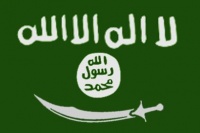Hizbul al-Harakat
DATE Africa > Hizbul al-Harakat ←You are here
Hizbul al-Harakat (translated as "The Party of Action"), more commonly known as al-Harakat is a jihadist fundamentalist group based in central East Africa. Its leadership had previously pledged itself to the militant Islamist organization Al-Qaeda, but quarrels and interpersonal conflicts led to al-Harakat distancing itself from the group. Since then, the group has withdran from the major cities, controlling a few rural in the rough maintains of western Nyumba.
Al-Harakat is an offshoot of the Nyumban Islamic Judicial Union (IJU), which lost much of its political standing following a popular rejection of some of its more radical rulings. The group describes its purpose as waging jihad against "enemies of Islam", and is engaged in combat against the Government of Nyumba and the Regional Standby Force (RSF). Al-Harakat has been designated as a terrorist organization by Australia, Canada, the United Arab Emirates, the United Kingdom and the United States.
Contents
Organization and Leadership
Al-Harakat’s membership is multiethnic, with its leadership positions mainly occupied by Iraq-trained ethnic Nyumbans and foreigners. The group's rank-and-file members hail from disparate local groups, sometimes kidnapped or recruited by force. Unlike most of the organization's top leaders, its foot soldiers are primarily concerned with nationalist and clan-related affairs as opposed to the global jihad. They are also prone to infighting and shifting alliances. Al-Harakat seeks to leverage these low-level grievances by manipulating clan networks in order to retain power. The group leader also experiences pressures from local politics and ethnic biases. In the last few years, new Muslim converts have been imported from neighbouring countries to do difficult operations or tasks that local members might find objectionable.
Foreign Fighters
Al-Harakat is known to have many foreigners within its ranks, particularly at the leadership level. [25][50] Fighters from the Persian Gulf and international jihadists were called to join the holy war against the Nyumba government and regional allies. Though Nyumban Islamists did not originally use suicide bombing tactics, the foreign elements of al-Harakat have been blamed for several suicide bombings.
Formerly a predominantly nationalist organization, al-Harakat branded itself as a the militant Islamist group of action and has attracted a large cadre of Western devotees. The group’s social media efforts have been particularly effective in Europe and the United States. The exact number of western recruits is unknown, but there have been numberous would-be members arrested by western law enforcement and more than two dozen have been killed in Nyumba.
These American and foreign recruits fulfil a dual purpose within the organization, serving as mercenaries and as a highly effective propaganda tool for radicalization and recruitment. These individuals have appeared in propaganda videos posted in online forums to appeal to disaffected Muslim youth and inspire them to join the Islamist struggle. It has also been reported that the group is attracting an increasing number of non-Nyumban recent converts from Amari. These "Amari Mujahideen" are typically young and overzealous. They can blend in with the general population of Amari and are often harder to track by law enforcement.
Foreigners play an important role in the group's activities due to their combat experience. These fighters bring with them specialized skills, often leading the indoctrination of new recruits, and providing training in remote-controlled roadside bombings, suicide attack techniques, and the assassination and kidnapping of government officials, journalists, humanitarian and civil society workers.
Strength and Equipment
Al-Harakat’s highest troop strength was estimated at less than 8,000 fighters in 2013, but is likely reduced to approximately 7,000. Fighters have used small arms, grenades (including rocket-propelled grenades), and limited quantities of crew-served weapons. They may also have a limited number of captured armored personnel carriers and MANPADs.
Ethnic and Grievance-based Violence
Locally-recruited fighters have evolved their activities to include ethnic and grievance-based violence. In the Nyumba border region near Archer’s Post, mlitiamen reportedly killed and decapitated at least 40 policemen, spared only those who spoke their language. Members have allegedly committed a variety of ethnically motivated atrocities in villages along the Nyumba-Amari border. Group members have been blamed for atrocities such as indiscriminate amputations, live-burnings, and mutilation of children and pregnant women.
Child soldiers
Evidence has been presented that perhaps as many as 30% of al-Harakat militias are children under the age of 14, with some as young as six. Most of these child fighters were kidnapped and are kept under control by force and drug addiction.
Rumors of Nyumban Collusion
A series of leaked documents have indicated that elements of the Nyumba military have used al-Harakat fighters to conduct probing attacks across the Amari border and into western Kakuma region. In the latter’s case, mostly foreign fighters conducted ambushes on rebel militia strongholds. The government of Nyumba has repeatedly denied the validity of the documents.
| DATE Africa Quick Links . | |
|---|---|
| Regional | Politics • Military • Economics • Social • Information • Infrastructure • Physical Environment • Time |
| Amari | Politics • Military • Economics • Social • Information • Infrastructure • Physical Environment • Time |
| Kujenga | Politics • Military • Economics • Social • Information • Infrastructure • Physical Environment • Time |
| Ziwa | Politics • Military • Economics • Social • Information • Infrastructure • Physical Environment • Time |
| Nyumba | Politics • Military • Economics • Social • Information • Infrastructure • Physical Environment • Time |
| Groups | Links (TBD) |

